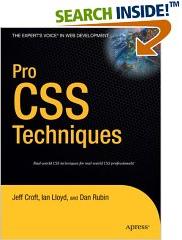|

Review by Frank Stepanski (Philadelphia):
There are many CSS books on the market now, so distinguishing yourself from the many is
getting harder and harder to do. Since there are less intermediate to advanced books
compared to beginner CSS books this is a start. Another thing this book focuses on that is
different than the majority of other CSS book is that is stresses creating semantic markup
throughout the design and development process. Semantic markup means understanding the
meaning of the XHTML that you write. What this means is that the code is free of presentational
information using only <div> and <span> when absolutely necessary.
These two tags can be very useful in creating intricate CSS designs but they have no semantic
meaning. Many blog posts have called this "divitis" because their web page is just a whole
bunch of <div> tags with identifiers (id or class) and that's it. While this visually
helps the designer quickly create the site, to screen-readers, or PDAs or cell phones may
not render the page exactly as you may think it should and using semantic markup helps the
browser for that particular device render that page that makes the most sense. It is a
hard concept to grasp or fully explain (as I probably am not), but it is used more and
more in current web practices.
Now this book is written by a couple different authors which seems like the norm
nowadays. [...] They all have contributed to various blogs (including their own) about web
design techniques and many of them are here in this book. ... This is a great book for
anybody wanting to further their CSS knowledge and experience by learning techniques that
are used by some of the top designers out there. A must buy!
Review by Nathan Smith (SonSpring.com):
"This book is a collection of proven, professional, modern techniques that you can use
every day to get the most out of the time you put into your projects... This book is not
an introduction to CSS. Although we'll provide an overview of the basics, we'll assume you
have a simple understanding of CSS and how it works."
Because the devil is in the details when it comes to CSS, this is exactly the type of
book that is needed. CSS is like chess, simple in principle yet complex in application.
It's like the old adage: "A day to learn, a lifetime to master." I've never met a web
developer who has had trouble mastering the concepts behind CSS. Agony is caused by
multi-browser implementation of advanced layouts.
Don't get me wrong, I think introductory books are necessary, and in fact one of my
favorite ones is Eric Meyer's Definitive Guide to CSS. Not every book needs to be the
Encylopedia Britannica of programming languages. Pro CSS Techniques is more in line with
CSS Mastery in the approach that it takes. ...
This is a great book, and would make an excellent addition to the arsenal of any
client-side developer. The appendices are worth the price alone, containing CSS Reference,
Specificity and Browser Grading charts. These provide a great way to see side-by-side
comparisons of which CSS techniques are well supported, and those we can salivate over
until they hit the mainstream. Bottom line, if CSS puts bread on your table, this book
will make you more productive.
Learn More ...
| 
